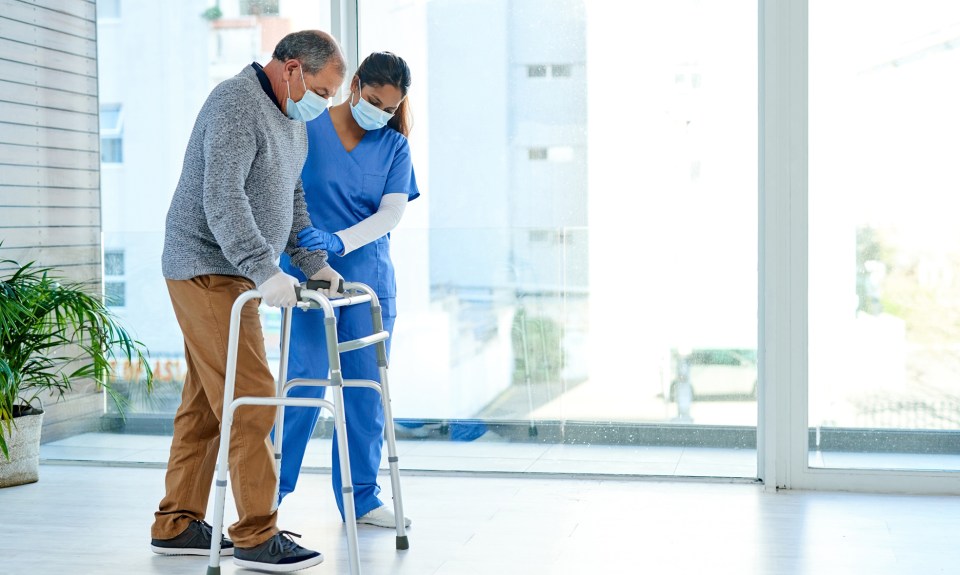No matter what the setting of care, falls present a serious risk to patients and can cause a setback in their recovery, making fall prevention a priority for most providers.
According to the CDC, one out of five falls causes serious injury, and each year, more than 3 million older adults are treated for fall-related injuries in the emergency department.
While there are several fall assessments out there for healthcare providers to determine a patient’s fall risk, most of them are based on the acute care setting. Fall risks are different in post-acute care and, more specifically, in inpatient rehabilitation, said Mary Ellen Hatch, vice president of nursing operations for Encompass Health.
As a provider of inpatient rehabilitation, Encompass Health patients are typically older—the average age is about 74—and most are experiencing cognitive and/or functional deficits after a serious illness or injury. As opposed to an acute patient stay, patients are required to spend at least three hours a day, five days a week in therapy and are not confined to a hospital bed during the majority of their stay.
Because of this, the fall assessment for these patients needs to be different than that of an acute provider.
“The problem is not different, but the way we assess them should be,” she said. “The needs of our patients are different. There are fall models out there, but they don’t meet our patients’ needs. We can’t just say they are high risk and put a sign on their door and tell them to stay in bed.”
Developing a Fall Prevention Model Specific to Inpatient Rehabilitation
In May, Encompass Health kicked off its fall prevention model pilot in 11 hospitals. Before the pilot, Encompass Health clinical leaders worked with data scientists at Cerner to develop a predictive model to assess fall risks within the inpatient rehabilitation setting.
Using 400,000 electronic medical records from past Encompass Health patients the predictive model identified 54 clinical features that increase a patient’s risk of falling in the inpatient rehabilitation setting. These risk factors include medications, diagnosis, physical and cognitive function and vital signs, to name a few.
The model begins running at admission. All patients are considered high risk during this period until more detailed assessments can be performed.
“At the admission level, they stay at high risk, so we treat them as such until we can truly determine the need,” Hatch said. “It’s been really exciting to have this tool that looks at our patient population and narrows it down to see what the risks are, so therapy and nursing can work together to do something about it.”
The patient’s fall risk is updated in near-real-time in the patient’s electronic medical record and is displayed on an easy-to-read dashboard, so the care team can take the necessary action to prevent a fall.
Four months into the pilot, results were so good that it was be rolled out companywide in November. “We know this works well, so we didn’t want to hold off on expanding its use,” Hatch said. “We’ve seen a definite decrease in falls.”
In the pilot hospitals, there was a 20% decrease in falls. That represents potentially hundreds of falls that were prevented thanks to the model and actions taken by clinicians.
“One of the things our team determined is that other fall prevention models weren’t reliable for us,” said Cheryl Miller, vice president of therapy operations for Encompass Health. “This one is definitely more reliable in preventing a fall in the inpatient rehabilitation setting.”
Reducing Readmissions and Improving Outcomes
The fall model is not the first predictive model developed by Encompass Health. In 2017, the company rolled out its ReACT model, which aims to reduce the risk of an acute care transfer while a patient is at an Encompass Health hospital. In 2020, the company rolled out its Readmission Prevention Program, which aims to reduce the risk of a hospital readmission after a patient leaves an Encompass Health hospital.
As with the fall model, both these models were developed using data from Encompass Health’s EHR platform.
“We’re doing predictive modeling in our piece of the continuum,” Hatch said. “Nobody else can do that because nobody has the dataset as large as we do to look at rehabilitation patients. That’s huge, and it can really make a difference in our patients’ lives.”
The content of this site is for informational purposes only and should not be taken as professional medical advice. Always seek the advice of your physician or other qualified healthcare provider with any questions you may have regarding any medical conditions or treatments.



